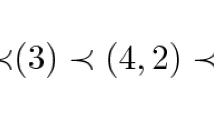Abstract
We consider TASEP with two types of particles starting at every second site. Particles to the left of the origin have jump rate \(1\), while particles to the right have jump rate \(\alpha \). When \(\alpha <1\) there is a formation of a shock where the density jumps to \((1-\alpha )/2\). For \(\alpha <1\) fixed, the statistics of the associated height functions around the shock is asymptotically (as time \(t\rightarrow \infty \)) a maximum of two independent random variables as shown in Ferrari and Nejjar (Probab Theory Rel Fields 161:61–109, 2015). In this paper we consider the critical scaling when \(1-\alpha =a t^{-1/3}\), where \(t\gg 1\) is the observation time. In that case the decoupling does not occur anymore. We determine the limiting distributions of the shock and numerically study its convergence as a function of \(a\). We see that the convergence to \(F_\mathrm{GOE}^2\) occurs quite rapidly as \(a\) increases. The critical scaling is analogue to the one used in the last passage percolation to obtain the BBP transition processes (Baik et al. in Ann Probab 33:1643–1697, 2006).





Similar content being viewed by others
Notes
In what follows we will not write the integer parts explicitly.
An up-right path \(\pi =\{\pi (0),\ldots ,\pi (n)\}\) is a sequence of points of \(\mathbb {Z}^2\) such that \(\pi (i+1)-\pi (i)\in \{(1,0),(0,1)\}\), for \(i=0,\ldots ,n-1\).
For a set \(S\), the notation \(\Gamma _{S}\) means a simple path anticlockwise oriented enclosing only poles of the integrand belonging to the set \(S\).
References
Baik, J., Ben Arous, G., Péché, S.: Phase transition of the largest eigenvalue for non-null complex sample covariance matrices. Ann. Probab. 33, 1643–1697 (2006)
Baik, J., Ferrari, P.L., Péché, S.: Limit process of stationary TASEP near the characteristic line. Commun. Pure Appl. Math. 63, 1017–1070 (2010)
Battles, Z., Trefethen, L.: An extension of Matlab to continuous functions and operators. SIAM J. Sci. Comput. 25, 1743–1770 (2004)
Bornemann, F.: On the numerical evaluation of distributions in random matrix theory: a review. Markov Process. Relat. Fields 16, 803–866 (2010)
Bornemann, F.: On the numerical evaluation of Fredholm determinants. Math. Comput. 79, 871–915 (2009)
Bornemann, F., Ferrari, P.L., Prähofer, M.: The Airy\(_1\) process is not the limit of the largest eigenvalue in GOE matrix diffusion. J. Stat. Phys. 133, 405–415 (2008)
Borodin, A., Ferrari, P. L., Prähofer, M.: Fluctuations in the discrete TASEP with periodic initial configurations and the Airy\(_1\) process. Int. Math. Res. Papers (2007), rpm002
Borodin, A., Ferrari, P.L., Prähofer, M., Sasamoto, T.: Fluctuation properties of the TASEP with periodic initial configuration. J. Stat. Phys. 129, 1055–1080 (2007)
Borodin, A., Ferrari, P.L., Sasamoto, T.: Transition between Airy\(_1\) and Airy\(_2\) processes and TASEP fluctuations. Comm. Pure Appl. Math. 61, 1603–1629 (2008)
Borodin, A., Ferrari, P.L., Sasamoto, T.: Two speed TASEP. J. Stat. Phys. 137, 936–977 (2009)
Borodin, A., Péché, S.: Airy kernel with two sets of parameters in directed percolation and random matrix theory. J. Stat. Phys. 132, 275–290 (2008)
Corwin, I., Ferrari, P.L., Péché, S.: Limit processes of non-equilibrium TASEP. J. Stat. Phys. 140, 232–267 (2010)
Corwin, I., Ferrari, P.L., Péché, S.: Universality of slow decorrelation in KPZ models. Ann. Inst. H. Poincaré Probab. Statist. 48, 134–150 (2012)
Ferrari, P.A.: Shock fluctuations in asymmetric simple exclusion. Probab. Theory Relat. Fields 91, 81–101 (1992)
Ferrari, P.A., Fontes, L.: Current fluctuations for the asymmetric simple exclusion process. Ann. Probab. 22, 820–832 (1994)
Ferrari, P.L.: Slow decorrelations in KPZ growth. J. Stat. Mech. P07022 (2008)
Ferrari, P.L., Nejjar, P.: Anomalous shock fluctuations in TASEP and last-passage percolation models. Probab. Theory Rel. Fields 161, 61–109 (2015)
Ferrari, P.L., Spohn, H.: Last branching in directed last passage percolation. Markov Process. Relat. Fields 9, 323–339 (2003)
Gärtner, J., Presutti, E.: Shock fluctuations in a particle system. Ann. Inst. H. Poincaré A 53, 1–14 (1990)
Gravner, J., Tracy, C.A., Widom, H.: Limit theorems for height fluctuations in a class of discrete space and time growth models. J. Stat. Phys. 102, 1085–1132 (2001)
Harris, T.: Additive set-valued markov processes and pharical methods. Ann. Probab. 6, 355–378 (1878)
Johansson, K.: Shape fluctuations and random matrices. Commun. Math. Phys. 209, 437–476 (2000)
Liggett, T.M.: Interacting Particle Systems. Springer, Berlin (1985)
Liggett, T.M.: Stochastic Interacting Systems: Contact, Voter and Exclusion Processes. Springer, Berlin (1999)
Prähofer, M., Spohn, H.: Scale invariance of the PNG droplet and the Airy process. J. Stat. Phys. 108, 1071–1106 (2002)
Sasamoto, T.: Spatial correlations of the 1D KPZ surface on a flat substrate. J. Phys. A 38, L549–L556 (2005)
Tracy, C.A., Widom, H.: On orthogonal and symplectic matrix ensembles. Commun. Math. Phys. 177, 727–754 (1996)
van Beijeren, H.: Fluctuations in the motions of mass and of patterns in one-dimensional driven diffusive systems. J. Stat. Phys. 63, 47–58 (1991)
Acknowledgments
P. L. Ferrari was supported by the German Research Foundation via the SFB 1060-B04 Project. P. Nejjar is grateful for the support of the Bonn International Graduate School (BIGS).
Author information
Authors and Affiliations
Corresponding author
Appendix: Kernel \(K_a\) in Terms of Airy Functions
Appendix: Kernel \(K_a\) in Terms of Airy Functions
Here we give the explicit form of \(K_a\) that we used for the numerical evaluation of \(G_a\) and its statistics.
Lemma 3.6
Denote \(u_{i,a}=u_i+a\) we have (with the conjugation transferred to the diffusion part)
Proof
The result is an easy computation that uses the identities
for any \(\delta >\max \{0,x\}\). \(\square \)
Remark 3.7
Alternatively, via the identity (A.6) of [9], one has
with an analogous formula for (4.5).
Rights and permissions
About this article
Cite this article
Ferrari, P.L., Nejjar, P. Shock Fluctuations in Flat TASEP Under Critical Scaling. J Stat Phys 160, 985–1004 (2015). https://doi.org/10.1007/s10955-015-1208-y
Received:
Accepted:
Published:
Issue Date:
DOI: https://doi.org/10.1007/s10955-015-1208-y




